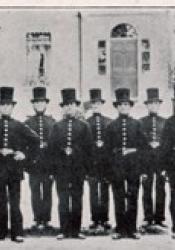The London Metropolitan Police Department
The first police department in Britain was the London Metropolitan Police Department which had been established by the Metropolitan Police Act in 1829. This police department was established by a British politician named Sir Robert Peel, and he outlined the nine policing principles which have heavily influenced police departments across the world since its development. Sir Rober Peel came to be known as the “Father of Modern Policing,” and the three core principles he developed were that the goal of the police is to prevent crime, earning public support and approval is the key to preventing crime, and the police earn support from the public by respecting the principles of the community. The Metropolitan Police Act officially established the principles of the police force, including that the officers should be uniformed, the structure of the police force will have a centralized, military-like structure, and the authority of the police should come from the crown. This police department had a hierarchical structure of ranks that was based on that of the military’s, and this structure has continued on even to today. The first common officers, the constables or “bobbies” as they were nicknamed, were unarmed (or lightly armed) and did not have a lot of authority. This London Metropolitan Police Department was intended, as Sir Robert Peel intended, to have close ties to the community, and it was established for the purpose of crime prevention.
While the principles of the police force were important, so too was the design of the police themselves. It was important that the police were easily distinguished from the military given the distinct roles they have. The color of the uniforms of the London Metropolitan Police Department were blue, the same as many police departments and forces today. This color was chosen by Robert Peel to help to differentiate the police force from the British military which wore red. This connection is particularly interesting as the police uniforms in the United States in its first police departments were also largely blue, but this was partially due to the police using surplus uniforms from the Union Army during the Civil War as well as the influence from Britain. The police departments’ uniforms were designed and worn so that officers could be easily recognized, and this is why they have an insignia indicating their department as well as badges with ID numbers to add an element of accountability. The difference in the distinction between the first London officers and the military versus the lack of distinction between the first police officers in the United States may be more important than it initially seems. While the police were designed to have a specific, distinctive role from the military, the overall design of the uniforms of the police and the military were very similar. In addition, the structure of the police departments was based on the structure of the military. This is an important connection to point out given the significant difference between the roles of the police versus the military, and it has been an important distinction from the first police department up to today.
The military was and is meant to protect its country’s citizens and fight against foreign powers and combatants. The police, on the other hand, are meant to prevent/react to crime and serve the citizens of their jurisdiction. The military engage with enemy combatants in order to maintain peace and be successful while the police engage with citizens. This distinction is key, and it has a huge role to play in the public’s perception of the police as a whole. It is important for the police to be able to view themselves as being on the same “side” as the public, and it is important for the public to view it this way as well. While the behavior and actions taken by the police has a major role to play, so too does the presentation of the police themselves. It is important for the police to look like protectors and crime preventers rather than like soldiers as they serve a different role than the military. This was readily apparent, as was previously stated, in London where the police wore a distinct color from the military and were largely unarmed or lightly armed.
The influence of the London Metropolitan Police Department is apparent still today. The policies, design, and structure was adopted by various major cities in the United States such as Boston, New York, and Los Angeles, and the influence carried on through the more than 12,000 local police departments that exist in the United States today. Many other countries have modeled their police departments after this original structure and design as well, and the influence of Sir Robert Peel and his policies will continue to be felt. The public’s overall perception of the police is largely determined by the appearance of the police and their uniforms, and the design and function of the police uniform can be linked back to the London Metropolitan Police Department.
References:
Anderson, P. (2020, July 04). The Roots and Perception of Police Uniforms. Retrieved October 12, 2020, from https://putthison.com/the-roots-and-perception-of-police-uniforms/
Banton, M., & Kelling, G. (2020, September 01). The development of professional policing in England. Retrieved from https://www.britannica.com/topic/police/The-development-of-professional-policing-in-England
Bureau of Justice Statistics Home page. (n.d.). Retrieved October 12, 2020, from https://www.bjs.gov/index.cfm?tid=71
Sir Robert Peel's Policing Principles. (2017, February 21). Retrieved October 12, 2020, from https://lawenforcementactionpartnership.org/peel-policing-principles/
Vaughn, C. (2018, June 06). [Digital image]. Retrieved from https://medium.com/@vaughncj02/the-foundation-opposition-and-the-eventual-formation-of-the-british-police-force-43c91e1be88d

